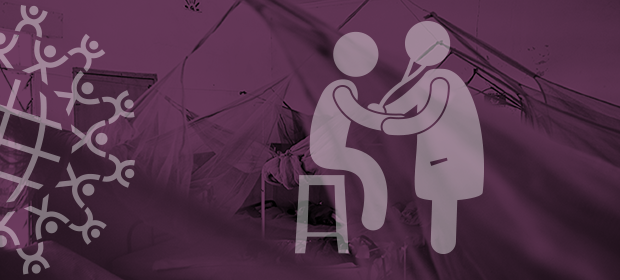Where We Work
See our interactive map


Each year, the country produces 2,000 new doctors and 7,000 new nurses. Yet there's often a shortage.
Poring over data from his native Democratic Republic of Congo this summer, Jean Lambert Chalachala uncovered some interesting—and troubling—aspects of the DRC’s health workforce.
For one thing, he says, a third of the nurses for whom there are data in the DRC are over 60 years old.
“Do you understand what this means?” he asks. “The official retirement age in the DRC is 60—they should be retired. And we will need new nurses to replace them.”
Since 2014, the DRC has been working with IntraHealth International to deploy iHRIS (pronounced “iris”) to eventually keep track of and manage all data on the country’s health workforce. The free, open source software developed by IntraHealth gives the DRC and 19 other countries a clear view of how many health workers they have, where those workers are stationed, whether their training is up-to-date, and much more.
Each year, the DRC produces at least 2,000 new doctors and 7,000 new nurses. Yet there's often a shortage.
As a University of North Carolina-IntraHealth fellow, Chalachala analyzed the iHRIS data generated by the DRC’s Ministry of Health. And an aging workforce, he found, is just one of the big challenges the health sector is now facing.
For years, Chalachala worked as a physician in the DRC, always in small, rural villages.
“In Africa, if you are a doctor in a rural area, you do not only do medicine,” he says. “You are the psychologist, you are the pastor, you are the marital adviser. You must be everything.”
He traveled around the country investigating and quashing suspicious outbreaks—some of which turned out to be nothing, but many of which proved to be meningitis, typhoid fever, and even Ebola.
“I know the DRC context—I know the names of many of the health facilities and villages because I have worked there,” he says. “So working with the iHRIS data, I never felt lost. Doing the first preliminary analysis of data available from Kinshasa—it was amazing.”
One thing that amazed Chalachala: the stark maldistribution of health workers the data revealed.
“Each year, the DRC produces at least 2,000 new doctors and at least 7,000 new nurses,” he says. “But when you go to the facilities, there are often not enough workers.”
The iHRIS data illuminated a crack in DRC’s health system, Chalachala found, that funnels more and more personnel to a handful of facilities that are already staffed to the gills, while leaving other hospitals short.
Chalachala describes two hospitals he knows well, each with the same capacity and serving populations of the same size.
“In one, iHRIS shows there are 10 medical doctors,” he says. “In the other, there are 200 doctors.”
The reason: a scattered process for managing the health sector’s human resources. This is a common issue in countries where health sector budgets are stretched and officials need to make tough choices without the benefit of accurate, up-to-date data.
Hospital heads end up with staff they may not need.
“In DRC, when you are an employee of the state, you have a guaranteed salary, even if you never attend your job,” Chalachala says. “As long as your name is on the list of hospital staff, at the end of the month, you get a paycheck.”
That makes the positions very attractive to newly graduating health workers, he says, who generally must forge their own paths through the bureaucratic maze that leads to steady employment.
Chalachala describes the process as he knew it during his time as a physician in the DRC: Imagine you’re a job-hunting health worker and you have friends who work in a desirable hospital, he says. You can ask them to add your name to the staff list. Once your name is on the list, you can then take it back to the three disparate ministries that manage the health sector’s human resources and negotiate and coax your way through the maze to land on a payroll.
This means that hospital heads often end up with staff they never asked for and may not need. And those physicians’ rotations may only come up every few weeks, Chalachala says. Meanwhile, physicians at a hospital down the road may be burning out as they struggle with staff shortages.
Now that the iHRIS data are available and shining a spotlight on the situation, Chalachala is optimistic that health officials will pay attention.
And soon, another tool will help further illuminate these workforce issues: WISN (or Workforce Indicators of Staffing Needs), which was developed by the World Health Organization.
The ministry doesn't yet know exactly how many health workers they have.
WISN helps health officials determine exactly how many and what types of health workers each individual facility must have to meet the needs of the populations they serve. Soon, IntraHealth will be helping the DRC to do just that.
“So what should the ministry do with all these people who graduate every year?” Chalachala says. “That's one of the big questions that iHRIS and WISN will help the Ministry of Health answer. Because right now, the ministry doesn't know exactly how many health workers they have or where they’re posted. But soon they can use these data and maybe say, ‘Look, in that hospital where we have 200 doctors. We really need only three.’”
As iHRIS and WISN are rolled out in the DRC, the IntraHealth will continue to work with the Ministry of Health as it mends the cracks in the country’s health system. IntraHealth’s work in the Democratic Republic of Congo is funded by the Department for International Development and the US Agency for International Development.
Get the latest updates from the blog and eNews




